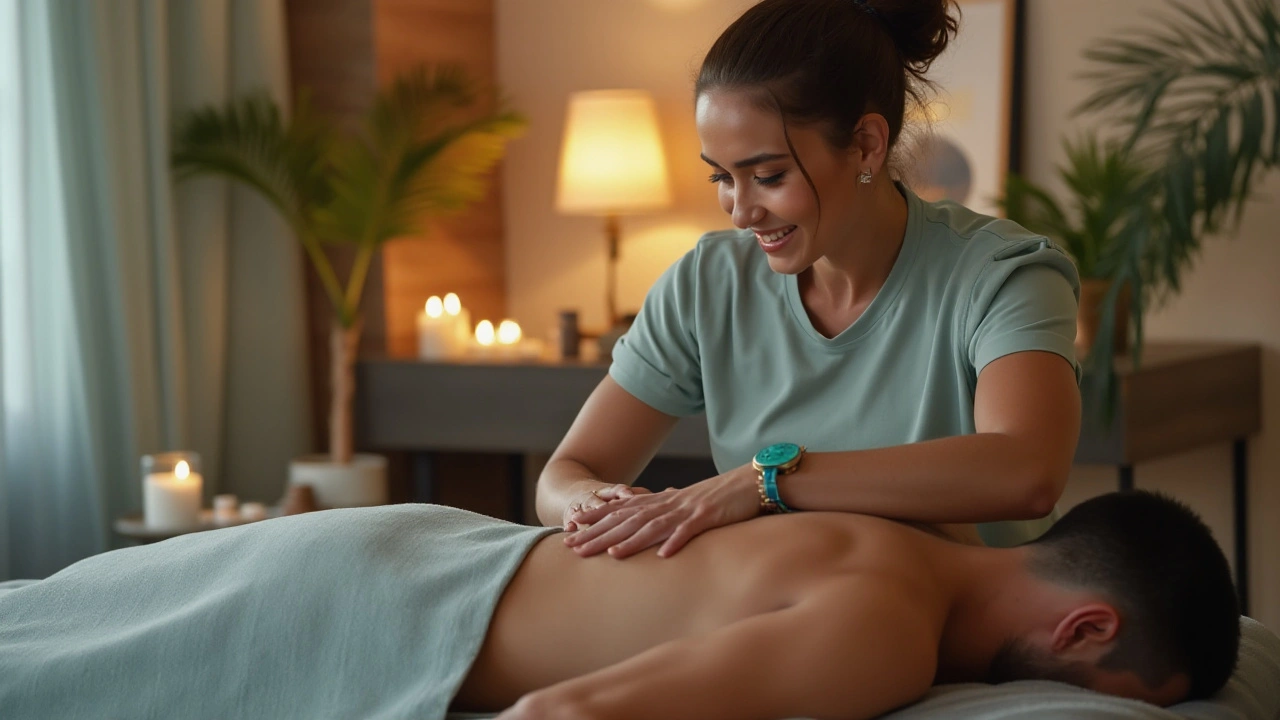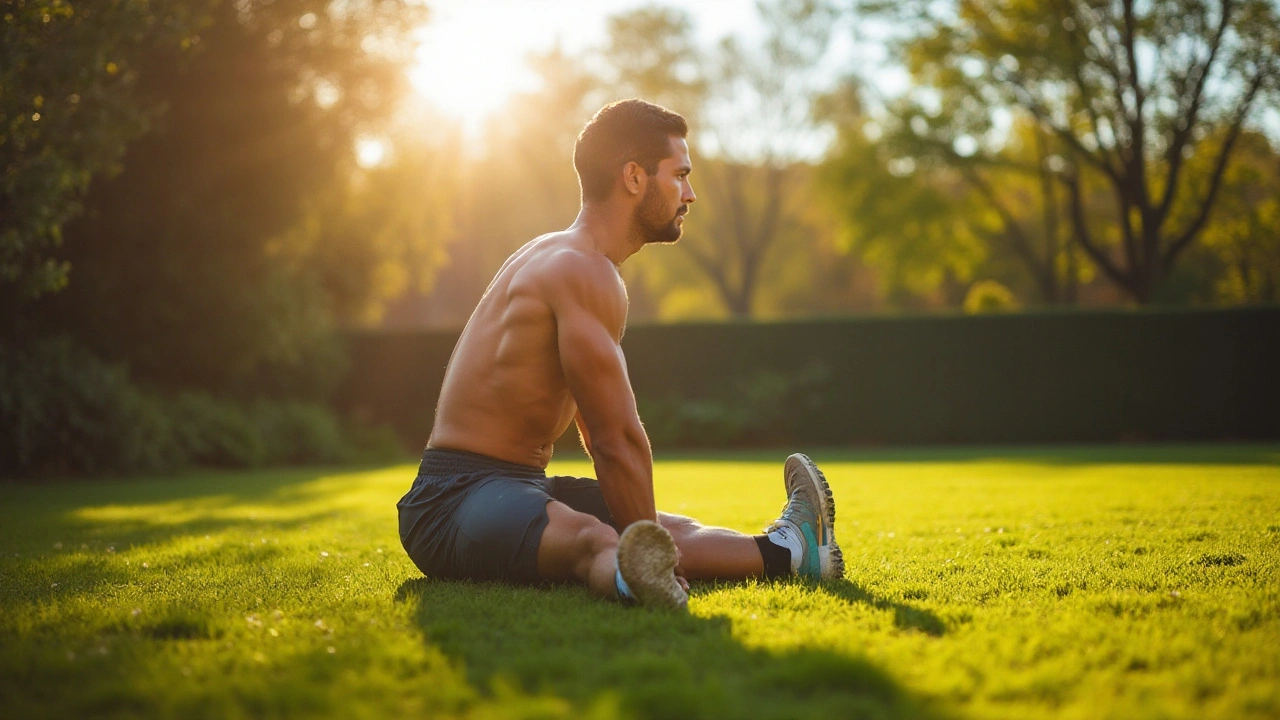
In the world of sports and physical fitness, staying in peak condition isn't just about regular training and proper nutrition. An often overlooked yet highly beneficial practice is sports massage therapy. Unlike typical relaxation massages, sports massage is a targeted approach aimed at athletes or active individuals seeking to enhance their performance and prevent injuries.
Sports massage encompasses a range of techniques designed to manipulate muscles, relieve tension, and improve circulation. This type of therapy is essential for anyone who pushes their body to the limits, helping to speed up recovery after intense workouts, reduce the risk of injury, and even increase flexibility and strength.
Intriguingly, the history of massage therapy traces back thousands of years, reflecting its timeless appeal and effectiveness. Today, many athletes swear by their regular sports massage sessions, considering them as integral as their training regimens and diet plans. But sports massage isn't reserved exclusively for professionals; it offers valuable benefits for anyone committed to regular physical activity. Understanding how to effectively incorporate this practice into a wellness routine can make a significant difference in how you feel and perform.
- The Essence of Sports Massage
- Benefits for Athletes
- Techniques and Methods
- Choosing a Sports Massage Therapist
- Incorporating Massage into Training
- Maintaining Muscle Health
The Essence of Sports Massage
The art of sports massage is rooted in ancient techniques but has evolved significantly to cater specifically to the needs of athletes and active individuals. At its core, this form of therapy aims to prepare the body for peak athletic performance and support ongoing muscle recovery. Unlike the typical stress-relief massages many are familiar with, sports massage is centred around functionality and efficiency, with each motion and technique designed to address specific requirements of those engaging in physical activities.
As practitioners delve into this specialized field, the massage techniques are carefully curated, with a focus on enhancing endurance, reducing recovery time, and minimizing the possibility of injury. They incorporate a combination of stretches, and deep tissue methods, which apply varying degrees of pressure to relieve tension effectively. Each session may be tailored to suit the unique condition and demands of the individual's sport or physical routine, targeting particular muscle groups used prominently in their activities.
One particularly fascinating aspect of sports massage is its ability to enhance blood flow and encourage the movement of lymph fluids. This circulation boost aids in the removal of lactic acid and other metabolic waste, which can accumulate during physical exertion, consequently easing muscle soreness and fatigue. An athlete's speed of recovery can thus be significantly improved by integrating regular sessions into their routine.
While many merely view massage as a luxury, the effectiveness of sports massage in boosting performance should not be underestimated. According to a study published in the Clinical Journal of Sports Medicine, athletes who received regular massages reported less pain and stiffness, alongside a notable improvement in flexibility. These enhancements are not just about physical gains; they contribute to better mental states, as easing physical discomfort often leads to increased focus and confidence.
“Massage has had a positive effect in various psychological factors such as reduction in anxiety and depression, which certainly boosts performance,” says Dr. Jane Smith, a renowned expert in sports medicine.
Moreover, sports massage is versatile, with applications before training or competing to warm up muscles, or after exertion to aid in the recovery process. This adaptability means that athletes can benefit from its effects throughout different phases of their training cycles. Whether it is the intensity of competitive soccer or the endurance required in long-distance running, the approach is finely tuned to meet each challenge posed by specific sports.
In the athletic world where precision is key, and every second or ounce of energy matters, muscle recovery and health management through such massages become indispensable. The evidence is clear: incorporating sports massage into an athlete's routine is more than just a supplementary activity; it becomes a cornerstone of achieving and sustaining peak physical performance.
Benefits for Athletes
For athletes, investing in sports massage is much more than a luxury—it's a necessity. This specialized massage form provides tailored solutions to enhance performance and overall muscle health. Muscle recovery from strenuous activity is significantly boosted as sports massage increases blood flow, providing muscles with the nutrients and oxygen they crucially need to repair and grow stronger.
Regular sessions help athletes maintain optimal flexibility, a crucial factor for both performance and injury prevention. Many injuries sportspeople experience, originate from overworked and stiff muscles. By breaking down muscle adhesions and promoting relaxation, sports massage helps to extend the natural range of motion and increases elasticity, allowing athletes to move with greater agility and comfort.
Interestingly, sports massage also plays a vital role in an athlete's mental preparation and recovery. The benefits of lowering the levels of stress hormones while enhancing relaxation and mood cannot be overstated. Perhaps, this is why numerous elite athletes incorporate massage into their weekly routines. The mind-body connection that athletes develop during massage can be a powerful tool in achieving peak performance. After all, when the mind is relaxed, and the body is free of tension, athletes are better equipped to focus on their training and competition.
"Sports massage helps me stay ahead of the game, both mentally and physically," asserts renowned marathon runner, Eliud Kipchoge, who often shares insights about his wellness routine's impact on his record-breaking achievements.
In addition to these advantages, a structured massage routine also provides valuable feedback about body condition, often identifying potential muscular issues before they escalate into serious injuries. Regular interaction with a skilled therapist may reveal subtle changes in muscle tone or flexibility, offering insights that can guide training and prevention strategies.
Enhancing Performance
Improving circulation is at the core of what makes sports massage an effective performance enhancer. Better blood circulation means more efficient removal of waste products like lactic acid, a known factor in muscle soreness and fatigue. With lactic acid gone, the recovery period decreases, allowing athletes to bounce back, ready for the next challenge sooner.
When considering the intensity and rigor involved in athletic training, it's clear how valuable sports massage is to maintaining a balanced and effective training regimen. Athletes who integrate this practice find themselves not only rehabilitated swiftly but often more attuned to their physical responses, adapting their strategies with insightful precision and care.

Techniques and Methods
When it comes to sports massage, the variety of techniques employed is quite fascinating and specifically tailored to address the unique needs of athletes and active individuals. One of the primary methods used is deep tissue massage, which delves into the deeper layers of muscles and connective tissues. This technique is particularly beneficial for breaking down adhesions, which are bands of painful, rigid tissue that can form after an injury. By targeting these areas, deep tissue massage helps restore normal movement and alleviate pain.
Another common practice is trigger point therapy. This method targets specific areas of tight muscle fibers that can cause pain in other parts of the body, known as referral pain. Through careful pressure and release techniques, therapists can effectively disable these "knots" and reduce tension, thus improving an athlete's range of motion and performance. Sports massage may also incorporate a series of stretching techniques, such as myofascial release, which involves gentle pressure and stretching of the muscles and fascia. This not only boosts flexibility but also fosters better circulation, ensuring that nutrients and oxygen are efficiently delivered to tissues throughout the body.
Muscle recovery is greatly enhanced through the use of effleurage—a series of gliding strokes aimed at stimulating blood circulation. By increasing the flow of blood, these strokes help with the removal of waste products from the muscles, which is crucial post-exercise. Interestingly, the technique known as petrissage—characterized by kneading and compressive actions—also aids in releasing deep muscular tension. This action is believed to increase the supply of essential nutrients to the muscles, thereby promoting faster healing and recovery. A noteworthy mention is the technique called proprioceptive neuromuscular facilitation (PNF), often utilized to increase flexibility. It involves a series of contract-relax stretching techniques that are highly effective for lengthening muscles and improving overall flexibility.
Combining Techniques for Maximum Impact
One of the most effective ways a sports massage therapist can aid an athlete is by combining different techniques to tailor a session according to specific needs. For example, employing both deep tissue massage and soft tissue release can be really effective in addressing chronic pain issues while ensuring that muscle function is optimized. Therapists also consider the timing of these massages—some techniques are best suited for pre-event preparation to warm up muscles and prevent injuries, while others are more beneficial post-event to cool down and relax the body.
"Studies indicate that a blend of various massage techniques can significantly enhance athletic performance and reduce recovery time," states the Sports Massage Association. This holistic approach ensures an athlete can maintain peak performance levels while safeguarding against potential injuries.
Additionally, cross-fiber friction techniques, which involve small, deep, back-and-forth movements, are often used to address adhesions and encourage the proper alignment of damaged muscle fibers. This method, combined with techniques like lymphatic drainage—ideal for combating fatigue and fluid retention—illustrates the comprehensive nature of sports massage therapy. A therapist's ability to integrate these varying methods effectively constitutes a key component of a successful sports massage practice.
Choosing a Sports Massage Therapist
Finding the right sports massage therapist can make a significant difference in your journey towards better muscle health and athletic performance. It is crucial to select a professional who not only has the right credentials but also understands your individual needs and goals. When beginning your search, start by asking fellow athletes for recommendations. Personal experiences can often provide insights into the therapist’s style and effectiveness. While recommendations are valuable, it's also important to verify the therapist’s qualifications. Make sure they have the appropriate certification from a recognized body and an understanding of anatomy, physiology, and exercise science. A sports massage therapist should be well-versed in various massage techniques and know how to apply them to different athletic conditions.
Experience is another key factor to consider. Look for a therapist with a background in working with athletes of your level, whether you are a professional competitor or a casual runner. This experience will enable them to tailor their techniques to your specific activities and potential ailments. A good therapist will also be able to communicate effectively with you. They should listen carefully to your concerns, ask pertinent questions about your training regimen, and explain how their massage techniques will benefit you. Communication is a two-way street, so be sure to express any preferences or issues you might have. For example, some might prefer deeper pressure to release muscle tension, while others seek a lighter touch.
In your selection process, also consider the logistics such as the location of the practice, availability of appointments, and price range. Some people find it easier to stick with regular sessions when the therapist's office is conveniently located. Additionally, inquire if the therapist offers customized packages or discounts for frequent appointments, especially if you plan on making sports massage a routine part of your training. It’s also worth asking if they offer any additional services like stretching techniques or advice on injury prevention that could enhance your overall wellness. Remember, the right fit varies from person to person, and it may take a few tries to find the therapist who meets all your requirements.
“The primary goal of sports massage is to support peak performance by maintaining the muscles in optimum condition,” says Helena Whitman, a renowned physiotherapist and sports massage expert. “It's not just about relieving soreness but also about preparing the body for every athletic endeavor.”
Many professional athletes allocate time for regular therapy benefits through massage and swear by its impact not just on muscle recovery but also psychological readiness. This practice can significantly reduce the risk of injuries by ensuring your muscles are supple and ready before any strenuous activity. A detailed discussion during initial consultations will give you an idea of how the therapist plans to assist in maximizing your performance and aiding recovery. Lastly, trust your instinct; a session with the right sports massage therapist should leave you feeling rejuvenated and ready to tackle your training with renewed vigor.

Incorporating Massage into Training
Embracing sports massage as a regular component of your training regime could be a total game-changer. Not only does it help ease muscle tension and soreness, but it also enhances your flexibility which can lead to significant improvements in performance. Consider athletes like marathon runners or professional footballers; they often include massage as part of their routine warm-ups and cool-downs. This isn't just about pampering muscles after a workout—the benefits of sports massage have been proven to enhance athletic performance by accelerating muscle recovery and reducing downtime. What’s really fascinating is how massage potentially influences the nervous system, making it more adept at responding to the strenuous demands of sports.
Experts recommend integrating massage at key points in your training cycle. For example, scheduling a session just a day or two before a major event can help prime muscles for peak performance. Moreover, post-event massages are vital in reducing delayed onset muscle soreness (DOMS), which can be debilitating if not managed effectively. Many athletes report feeling a rejuvenating effect post-massage that their usual recovery routines don't typically provide. As your body adapts to the rigors of consistent training, regular massages maintain the elasticity of tight areas while addressing any imbalances that might arise. It's worth noting that enhanced circulation from massage aids in faster removal of metabolic by-products, speeding up recovery.
Creating a structured plan when it comes to massages can be a brilliant strategy. For instance, implementing weekly or bi-weekly massages could offer continuous improvements in muscle tone and health. If you're working with a sports therapist, discussing your training and performance objectives is key. They can tailor techniques to align with your physical demands. Consider renowned sports figures who attribute part of their success to a well-planned massage therapy regime. Cristiano Ronaldo, for instance, is known for his commitment to meticulous recovery practices.
"Massage has been instrumental in maintaining my game-ready state," Ronaldo has shared in several interviews.Tailored interventions such as trigger point therapy or deep tissue massage are particularly beneficial when woven into your high-intensity training schedules.
Even for those who aren’t athletes, incorporating massage therapy can greatly benefit personal fitness goals. For example, a statistical study revealed that individuals engaging in regular physical activity experienced increased flexibility and decreased injury rates once they began a regimen that included massage. Regular sessions help maintain muscle health by preventing the onset of tightness and strains, which can be quite common during intense workout sessions. To maximize the benefits, consider adopting a simple yet effective post-massage routine—replenishing fluids, gentle stretching, and adequate rest. This comprehensive approach ensures your muscles are adequately nourished post-massage, allowing you to enjoy sustained benefits and continued progress in your fitness journey.
Maintaining Muscle Health
Muscle health extends far beyond achieving peak physical appearance. It's about ensuring flexibility, strength, and rapid recovery, which become especially crucial for both occasional gym-goers and professional athletes alike. Sports massage provides an excellent method to maintain muscle health by addressing the wear and tear that muscles endure during physical activities. Regular massage sessions can optimize the body’s range of motion, a factor crucial to athletic performance and preventing injuries. When muscles are relaxed, blood and nutrients flow more freely, which aids in faster recovery and the removal of toxins from body tissues.
An intriguing benefit of maintaining healthy muscles through massage is its impact on the body's recovery time. Studies have highlighted how, by loosening tension and combating lactic acid build-up, sports massage can lessen delayed onset muscle soreness, enabling athletes to get back on their feet sooner. Additionally, massage not only treats physical strain but also the mental fatigue that results from intense training. The therapeutic touch helps to soothe the nervous system, encouraging both mind and body relaxation. This holistic approach ensures athletes can stay sharp and focused, allowing them to give their best performance each time.
Psychological benefits should not be underestimated. Sports massage contributes to an athlete’s mental resilience. Stress, anxiety, and the pressure to perform can often weigh heavily on athletes. Incorporating regular massage therapy can act as a calming ritual, promoting better mental health, which directly influences physical performance. When athletes are mentally relaxed, they are more likely to enjoy their sports, further enhancing muscle coordination and efficiency.
According to a study published in the Journal of Sports Medicine, 'Regular sports massage can significantly reduce muscle stiffness and enhance overall performance by up to 20%.' These findings underscore the invaluable role massage therapy can play in maintaining optimal muscle condition.
How often should one indulge in sports massage for maintaining muscle health? This will largely depend on the level of activity and personal needs. For those in rigorous training schedules, weekly sessions might be ideal. Others may find monthly visits to suffice. While regular massage is beneficial, it's essential to remember that it should complement—not replace—a balanced workout and diet plan. Techniques such as deep tissue massage, Swedish massage, or trigger point therapy may each offer specific benefits, and a consultation with a certified therapist can help tailor the best plan for individual needs.
Ultimately, muscles need care akin to high-performance machines, which require regular maintenance to function smoothly. Ensuring muscle health through sports massage stands as an investment in one’s physique, helping to prolong an active lifestyle filled with vitality and wellness. As athletes and enthusiasts alike uncover this timeless method, the transformative effect it wields on muscle health and overall wellbeing becomes undeniably apparent.





